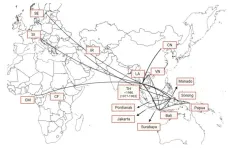(Press-News.org) Every day our brains strive to optimize a trade-off: With lots of things happening around us even as we also harbor many internal drives and memories, somehow our thoughts must be flexible yet focused enough to guide everything we have to do. In a new paper in Neuron, a team of neuroscientists describes how the brain achieves the cognitive capacity to incorporate all the information that’s relevant without becoming overwhelmed by what’s not.
The authors argue that the flexibility arises from a key property observed in many neurons: “mixed selectivity.” While many neuroscientists used to think each cell had just one dedicated function, more recent evidence has shown that many neurons can instead participate in a variety of computational ensembles, each working in parallel. In other words, when a rabbit considers nibbling on some lettuce in a garden, a single neuron might be involved in not only assessing how hungry it feels but also whether it can hear a hawk overhead or smell a coyote in the trees and how far away the lettuce is.
The brain does not multitask, said paper co-author Earl K. Miller, Picower Professor in The Picower Institute for Learning and Memory at MIT and a pioneer of the mixed selectivity idea, but many cells do have the capacity to be roped into multiple computational efforts (essentially “thoughts”). In the new paper the authors describe specific mechanisms the brain employs to recruit neurons into different computations and to ensure that those neurons represent the right number of dimensions of a complex task.
“These neurons wear multiple hats,” Miller said. “With mixed selectivity you can have a representational space that’s as complex as it needs to be and no more complex. That’s what flexible cognition is all about.”
Co-author Kay Tye, Professor at The Salk Institute and the University of California at San Diego, said mixed selectivity among neurons particularly in the medial prefrontal cortex is key to enabling many mental abilities.
"The mPFC is like a hum of whispers that represents so much information through highly flexible and dynamic ensembles," Tye said. “Mixed selectivity is the property that endows us with our flexibility, cognitive capacity, and ability to be creative. It is the secret to maximizing computational power which is essentially the underpinnings of intelligence."
Origins of an idea
The idea of mixed selectivity germinated in 2000 when Miller and colleague John Duncan defended a surprising result from a study of cognition in Miller’s lab. As animals sorted images into categories, about 30 percent of the neurons in the prefrontal cortex of the brain seemed to be involved. Skeptics who believed that every neuron had a dedicated function scoffed that the brain would devote so many cells to just one task. Miller and Duncan’s answer was that perhaps cells had the flexibility to be involved in many computations. The ability to serve on one cerebral task force, as it were, did not preclude them from being able to serve many others.
But what benefit does mixed selectivity convey? In 2013 Miller teamed up with two co-authors of the new paper, Mattia Rigotti of IBM Research and Stefano Fusi of Columbia University, to show how mixed selectivity endows the brain with powerful computational flexibility. Essentially, an ensemble of neurons with mixed selectivity can accommodate many more dimensions of information about a task than a population of neurons with invariant functions.
“Since our original work, we've made progress understanding the theory of mixed selectivity through the lens of classical machine learning ideas,” Rigotti said. “On the other hand, questions dear to experimentalists about the mechanisms implementing it at a cellular level had been comparatively under-explored. This collaboration and this new paper set out to fill that gap.”
In the new paper the authors imagine a mouse who is considering whether to eat a berry. It might smell delicious (that’s one dimension). It might be poisonous (that’s another). Yet another dimension or two of the problem could come in the form of a social cue. If the mouse smells the berry scent on a fellow mouse’s breath, then the berry is probably OK to eat (depending on the apparent health of the fellow mouse). A neural ensemble with mixed selectivity would be able to integrate all that.
Recruiting neurons
While mixed selectivity has the backing of copious evidence—it has been observed across the cortex and in other brain areas such as the hippocampus and amygdala—there are still open questions. For instance, how are neurons recruited to tasks and how do neurons that are so “open-minded” remain tuned only to what really matters to the mission?
In the new study, the researchers who also include Marcus Benna of UC San Diego and Felix Taschbach of The Salk Institute, define the forms of mixed selectivity that researchers have observed, and argue that when oscillations (also known as “brain waves”) and neuromodulators (chemicals such as serotonin or dopamine that influence neural function) recruit neurons into computational ensembles, they also help them “gate” what’s important for that purpose.
To be sure, some neurons are dedicated to a specific input, but the authors note they are an exception rather than the rule. The authors say these cells have “pure selectivity.” They only care if the rabbit sees lettuce. Some neurons exhibit “linear mixed selectivity,” which means their response predictably depends on multiple inputs adding up (the rabbit sees lettuce and feels hungry). The neurons that add the most dimensional flexibility are the “nonlinear mixed selectivity” ones that can account for multiple independent variables without necessarily summing them. Instead they might weigh a whole set of independent conditions (e.g. there’s lettuce, I’m hungry, I hear no hawks, I smell no coyotes, but the lettuce is far and I see a pretty sturdy fence).
So what brings neurons into the fold to focus on the salient factors, however many there are? One mechanism is oscillations, which are produced in the brain when many neurons all maintain their electrical activity at the same rhythm. This coordinated activity enables information sharing, essentially tuning them together like a bunch of cars all playing the same radio station (maybe the broadcast is about a hawk circling overhead). Another mechanism the authors highlight is neuromodulators. These are chemicals that upon reaching receptors within cells can influence their activity as well. A burst of acetylcholine, for instance, might similarly attune neurons with the right receptors to certain activity or information (like maybe that feeling of hunger).
“These two mechanisms likely work together to dynamically form functional networks,” the authors write.
Understanding mixed selectivity, they continue, is critical to understanding cognition.
“Mixed selectivity is ubiquitous,” they conclude. “It is present across species and across functions from high-level cognition to ‘automatic’ sensorimotor processes such as object recognition. The widespread presence of mixed selectivity underscores its fundamental role in providing the brain with the scalable processing power needed for complex thought and action.”
END
How the brain is flexible enough for a complex world (without being thrown into chaos)
Many neurons exhibit “mixed selectivity.” They can integrate multiple inputs and participate in multiple computations. Mechanisms such as oscillations and neuromodulators recruit their participation and tune them to focus on the relevant informatiion.
2024-05-10
ELSE PRESS RELEASES FROM THIS DATE:
Tracing HIV in Indonesia
2024-05-10
The HIV variant dominant in Indonesia was introduced from Thailand over multiple events. The Kobe University study traces where it came from and how it spread from there, offering insights of possible value to the development of treatments against the disease.
HIV is the virus causing AIDS, but one of the things that make it so difficult to treat is that there are many variants of it. Kobe University virologist KAMEOKA Masanori says, “The diversity is increasing every day and the prevalent virus strains differ from region to ...
Metabolism of autism reveals developmental origins
2024-05-10
Researchers at the University of California San Diego School of Medicine have shed new light on the changes in metabolism that occur between birth and the presentation of autism spectrum disorder (ASD) later in childhood. The researchers discovered that a small number of biochemical pathways are responsible for the majority of these changes, which could help inform new early detection and prevention strategies for autism.
“At birth, the physical appearance and behavior of a child who will develop autism over the next few years are indistinguishable from that of a neurotypical child. Indeed, in most cases the fate of the child with regard to autism is not ...
Comparative analysis of robot-assisted language learning systems and human tutors in English conversation lessons
2024-05-10
Advancements in large language models, robotics, and software such as text-to-speech, have made it possible to develop robots that can understand language, interact physically, and communicate verbally. These breakthroughs have opened up possibilities for robots to be used for educational purposes. However, this raises the question of whether robots are as good as human tutors. While robots offer certain benefits, they cannot replicate the nuanced interactions and personalized feedback human tutors provide.
To determine the suitability of using ...
Under 4-minute milers’ longevity shows that extreme exercise doesn’t seem to curb lifespan
2024-05-10
Extreme exercise doesn’t seem to shorten the lifespan as is widely believed, suggest the findings of a study on the longevity of the first 200 athletes to run a mile in under 4 minutes, and published online in the British Journal of Sports Medicine.
They outlive the general population by several years, shows the study, which marks the 70th anniversary of the seminal achievement of Roger Bannister, who was the first person to run a mile in under 4 minutes in May 1954.
While regular moderate exercise is considered a pillar of healthy ageing, ...
Journal retracts 6 further articles and corrects 2 others authored by former editor
2024-05-10
The British Journal of Sports Medicine has retracted six further articles authored by former editor, Dr Paul McCrory, and corrected another two, following an extensive investigation of his sole authored content in the journal.*
The retractions comprise four ‘warm up’ editorials and one book review due to plagiarism. A letter has also been retracted because of duplicate publication. And a research article and a review article have been corrected due to inappropriate reuse of content.
This latest tranche of retractions and corrections completes BMJ’s 2-year investigation ...
Running under a four-minute mile could be the key to a long and healthy life
2024-05-10
A new study released to mark the 70th anniversary of Sir Roger Bannister’s sub-four-minute mile record has revealed the first 200 runners to follow in his footsteps also share another remarkable trait.
The study from investigators in Australia and Canada found the 200 elite runners live on average almost five years longer than the general population.
Professor Mark Haykowsky, the Research Chair in Aging and Quality of Life in the Faculty of Nursing at the University of Alberta, says the findings published in the British Journal of Sports Medicine demonstrate the vital importance of aerobic fitness.
Professor Haykowsky says: “Breaking ...
Transforming common soft magnets into a next-generation thermoelectric conversion materials by 3 minutes heat treatment
2024-05-10
1. A research team from NIMS and Nagoya University has demonstrated that an iron-based amorphous alloy, widely used as a soft magnetic material in transformers and motors, can be transformed into a "transverse" thermoelectric conversion material that converts electric and thermal currents in orthogonal directions, with just a short period of heat treatment. This is the first example that highlights the importance of microstructure engineering in the development of transverse thermoelectric conversion materials, and provides new design guidelines for materials development to realize environmentally friendly power generation and thermal management technologies ...
Good vibrations: New tech may lead to smaller, more powerful wireless devices
2024-05-09
What if your earbuds could do everything your smartphone can do already, except better? What sounds a bit like science fiction may actually not be so far off. A new class of synthetic materials could herald the next revolution of wireless technologies, enabling devices to be smaller, require less signal strength and use less power.
The key to these advances lies in what experts call phononics, which is similar to photonics. Both take advantage of similar physical laws and offer new ways to advance technology. While photonics takes advantage of photons – or light – phononics does the same with phonons, which are the physical particles that transmit mechanical vibrations ...
Revolutionizing nurse work environment research
2024-05-09
PHILADELPHIA (May 9, 2024) – New research from Penn Nursing’s Center for Health Outcomes and Policy Research (CHOPR) – recently published online in the journal Research in Nursing & Health – has successfully validated a new, streamlined version of the Practice Environment Scale of the Nursing Work Index (PES-NWI), originally authored in 2002 by Eileen T. Lake, PhD, RN, FAAN, Professor of Nursing, the Edith Clemmer Steinbright Professor in Gerontology, and Associate Director of CHOPR, who is also lead author on this publication. This innovative tool, known as the PES-5, is designed to revolutionize how nurse work environments are measured across ...
New ‘forever chemical’ cleanup strategy discovered
2024-05-09
As the U.S. Environmental Protection Agency cracks down on insidious “forever chemical” pollution in the environment, military and commercial aviation officials are seeking ways to clean up such pollution from decades of use of fire suppressant foams at military air bases and commercial airports.
Fire-suppression foams contain hundreds unhealthful forever chemicals, known by chemists as PFAS or poly- and per-fluoroalkyl substances. These compounds have stubbornly strong fluorine-to-carbon bonds, which allow them to persist indefinitely in the environment, hence the moniker “forever chemicals.” ...
LAST 30 PRESS RELEASES:
Numbers in our sights affect how we perceive space
SIMJ announces global collaborative book project in commemoration of its 75th anniversary
Air pollution exposure and birth weight
Obstructive sleep apnea risk and mental health conditions among older adults
How talking slows eye movements behind the wheel
The Ceramic Society of Japan’s Oxoate Ceramics Research Association launches new international book project
Heart-brain connection: international study reveals the role of the vagus nerve in keeping the heart young
Researchers identify Rb1 as a predictive biomarker for a new therapeutic strategy in some breast cancers
Survey reveals ethical gaps slowing AI adoption in pediatric surgery
Stimulant ADHD medications work differently than thought
AI overestimates how smart people are, according to HSE economists
HSE researchers create genome-wide map of quadruplexes
Scientists boost cell "powerhouses" to burn more calories
Automatic label checking: The missing step in making reliable medical AI
Low daily alcohol intake linked to 50% heightened mouth cancer risk in India
American Meteorological Society announces Rick Spinrad as 2026 President-Elect
Biomass-based carbon capture spotlighted in newly released global climate webinar recording
Illuminating invisible nano pollutants: advanced bioimaging tracks the full journey of emerging nanoscale contaminants in living systems
How does age affect recovery from spinal cord injury?
Novel AI tool offers prognosis for patients with head and neck cancer
Fathers’ microplastic exposure tied to their children’s metabolic problems
Research validates laboratory model for studying high-grade serous ovarian cancer
SIR 2026 delivers transformative breakthroughs in minimally invasive medicine to improve patient care
Stem Cell Reports most downloaded papers of 2025 highlight the breadth and impact of stem cell research
Oxford-led study estimates NHS spends around 3% of its primary and secondary care budget on the health impacts of heat and cold in England
A researcher’s long quest leads to a smart composite breakthrough
Urban wild bees act as “microbial sensors” of city health.
New study finds where you live affects recovery after a hip fracture
Forecasting the impact of fully automated vehicle adoption on US road traffic injuries
Alcohol-related hospitalizations from 2016 to 2022
[Press-News.org] How the brain is flexible enough for a complex world (without being thrown into chaos)Many neurons exhibit “mixed selectivity.” They can integrate multiple inputs and participate in multiple computations. Mechanisms such as oscillations and neuromodulators recruit their participation and tune them to focus on the relevant informatiion.





